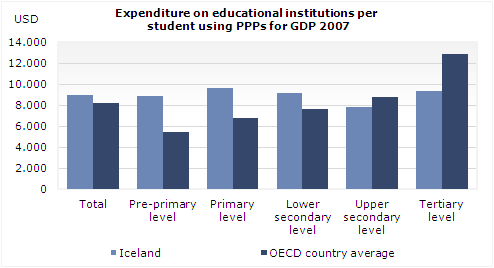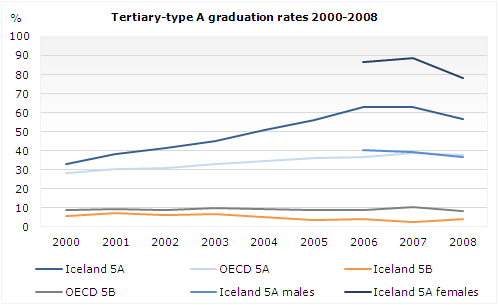Investment in education pays off, both for the individual and for society. Public resources invested in education pay off in even greater tax revenues. In addition, education has a positive effect on society that is not measured in tax income. This information comes from the publication "Education at a Glance 2010, OECD Indicators", just published by the OECD (Organisation for Economic Co-operation and Development). The publication includes information on education in the 31 member countries. Additional information can be found for Brazil, China, Estonia, India, Indonesia, Israel, the Russian Federation and Slovenia. The data are mainly from the school year 2007-2008. The majority of data on Iceland are based on information from Statistics Iceland.
The publication comprises four chapters that discuss: The output of educational institutions and the impact of learning; financial and human resources invested in education; access to education, participation and progression, and the learning environment and the organisation of schools. The publication includes numerous tables and charts. Additional material can be found on the OECD website.
Iceland spent more on education than any other OECD country in 2007
In general it can be stated that a country’s age distribution and participation in education has considerable influence when comparing expenditure on education. Expenditure is usually higher in countries with a young population and where students are a large proportion of the population, as is the case in Iceland.
Iceland’s expenditure on educational institutions amounted to 7.8% of GDP in 2007 which puts Iceland in first place among the OECD countries. The weighted average for the OECD was 6.2% of GDP and the average for the OECD countries was 5.7%. Expenditure on educational institutions in Iceland as a percentage of GDP has dropped by 0.2% since 2006. A total of 17.4% of public expenditure was devoted to education in Iceland in 2007 while the average for the OECD countries was 13.3%. In all OECD countries with comparable data public expenditure on education increased between 2000 and 2007. However, private expenditure on education increased even more than public expenditure in more than ¾ of OECD countries. In spite of the increase in private expenditure 82.6% of expenditure on education comes from public sources.
When considering expenditure per student from primary to tertiary education the OECD countries spent on average 8,216 USD per student in 2007. Iceland spent 9,015 USD on average per student and is 11th among the OECD countries. Iceland spent more than the OECD average at the pre-primary level (2nd place) and on compulsory education (4th place at the primary level and 10th place at the lower secondary level) but below the OECD average at the upper secondary level (18th place) and the tertiary level (20th place).

Older students in Iceland and a greater gender difference than in other countries
In Iceland older students are more numerous among graduates from the upper secondary and tertiary levels of education than in most other OECD countries. The net graduation rate is computed by adding up age-specific graduation rates. The net graduation rate at the upper secondary level in Iceland is 89% but 68% when only counting students under the age of 25. The difference is particularly large in vocational education where the graduation rate is 55% but 29% when only counting students under the age of 25. The net graduation rate is 74% for males and 105% for females. In no other OECD country is the difference between males and females this large. The average for the OECD countries is 80% for all students.
Icelandic university students are older than students in other OECD countries when they enter university education. One-half of new entrants in tertiary-type A education in Icelandic universities are older than 23.2 years old, but 20.4 years old on average in the OECD member countries. The net graduation rate in tertiary-type A programmes in Iceland is 57% but 35% when only counting students under the age of 30. The net graduation rate is 37% for males and 78% for females. The average for the OECD countries is 38% for all students. In no other OECD country is the difference between males and females this large at the tertiary-type A level. The relatively large number of older students at the upper secondary and tertiary levels of education points to an open school system where it is easy to continue studying for students who did not complete their studies at the conventional age.

Young Icelandic women are more likely than men to hold a job requiring lower education than they have completed
In Iceland women are more likely than men to hold a job that requires lower education than they have completed. Thus, 21% of 25-29 year old Icelandic women and 11% of men who have completed tertiary education hold a job that does not require tertiary education, such as office or service jobs. The average for the OECD countries is 23% for males and 22% for females. In addition, 6% of Icelandic women and 3% of men who have completed upper secondary education hold jobs that do not require any specialisation, while the average for the OECD countries is 7% both for males and females.
The basic salary of teachers in Iceland as a proportion of salaries of people with tertiary education is among the lowest in the OECD countries
The ratio of the salaries of teachers with minimum education after 15 years of experience in compulsory education when compared with the salaries of 25-64 year old people with tertiary education working full-time is 0.50 in Iceland in 2006 but 0.77 on average at the primary level and 0.79 at the lower secondary level in the OECD countries in 2008. The teachers’ salaries in the Czech Republic and Hungary are similar to salaries in Iceland but in other OECD countries the ratio is higher. The situation is similar at the upper secondary level; there the ratio is 0.61 for Iceland but 0.86 on average for the OECD countries. The salaries of teachers at the upper secondary level are lower in the Czech Republic, Hungary and Italy than in Iceland, but higher in other OECD countries. The OECD points out that care must be taken when teachers’ salaries are compared internationally. Teaching time is different between countries and class size varies. Additional payments are not included, neither are taxes nor various other public payments.
Possibilities for parents to choose a school for their children have increased
The publication includes results from the first international survey on school choice and parent voice in compulsory education. The results indicate that in most countries pupils are assigned to public schools based on residence, but usually parents can choose other schools if they want. The possibilities for parents to choose a school for their child have increased in the last 25 years. In 18 out of 30 OECD countries there are school governing boards with parental representation, including Iceland. In 10 out of 26 countries the government is required to consult parent associations on major policy decisions, including in Iceland.
OECD’s press release on Education at a Glance can be found on the OECD website.